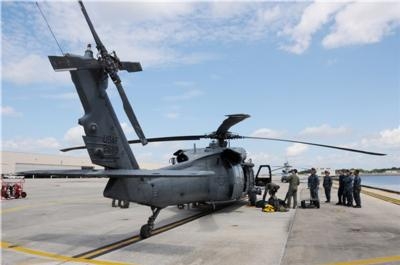HH-60 Pave Hawk Arrives At Navy's Fleet Readiness Center Southeast In Jacksonville, FL For 600-Hour Inspection
A new era began at Fleet Readiness Center Southeast (FRCSE) on Sept. 11 with the arrival of the first Air Force HH-60 Pave Hawk helicopter. Col. Daniel Lapastole, vice commander, 129th Rescue Wing, landed the aircraft at Naval Air Station Jacksonville after a four-stop, cross-country trek from the unit’s home at Moffett Federal Airfield, California.

Fleet Readiness Center Southeast officials hope the aircraft will be the first of many to undergo a 600-hour phase inspection at the Jacksonville facility. “This is monumental, because it establishes a new capability,” said Jon Stafford, FRCSE’s aircraft and structural/mechanical division manager. “Our program is growing expeditiously.”
The 600-hour phase inspection is usually performed at the squadron level, but Air Force manpower demands elsewhere sent the service searching for alternatives, according to FRCSE’s Vertical Lift IPT Team Lead Angelo Evans. Yet ultimately, it was the well-known proficiency of FRCSE’s vertical lift team that sealed the deal, Stafford said. “The Air Force realized our outstanding capabilities of repairing Navy aircraft and modifications, and asked if we could take on this 600-hour phase inspection,” he said. “It was really the job performance of our artisans and production teams that allowed us this opportunity.”
Stafford praised the team’s recent record, which, for FY15, includes a roughly 90-percent rate of on-time delivery.
Though the Pave Hawk is a new platform to FRCSE, it bears a heavy resemblance to the familiar Navy SH-60 Sea Hawk and shares the same T700 power plant. If the Pave Hawk needs engine repairs, there are Sailors at FRCSE Detachment Mayport with plenty of experience fixing them. “The Sailors at Mayport specialize in these engines,” Evans said. “They have all the tooling, fixtures, manpower and expertise.”
The vertical lift team will send artisans, many of them veterans with previous experience on the T700, to Mayport to work with the Sailors. “There will be some pretty heavy integration,” Evans said. “This time, the Sailors are going to be training our artisans on how to work on these engines.Our team will do the hands-on work, but the Sailors are going to show them how to perform the repairs using the Mayport facility.”
Building FRCSE’s capability on the aircraft is critical to securing future agreements involving the Pave Hawk, according to Joey Milstead, FRCSE business management specialist. “We will establish the capability and hope that ‘build it and they will come,’” she said.
Evans said the vertical lift team is ready for the challenge. “Our goal is to complete the inspection and repairs in 60 days or less,” he said. “We are showing the Air Force that we have a great team of skilled artisans working on this platform and we'll get the job done.”
The 600-hour phase increases the workload for FRCSE, but it is a relatively short-term job at an estimated 1,900 work hours. However, more intensive tasks could lie ahead once the project is completed, Evans said. “Joint depot level maintenance is the next step up from the 600-hour phase and that involves about 15,000 to 19,000 hours per aircraft. So that means more work for the depot.”
The Pave Hawk is a critical tool for the Air Force and Air National Guard units. The helicopter’s main role is search and rescue, whether it’s rescuing civilians at home or finding downed pilots in hostile environments abroad. “The only thing more important than getting something on-target, is getting personnel off-target if they’re down,” Stafford said. “That’s what these aircraft do.”
The vertical lift team expects to complete the first Pave Hawk by mid-November, Evans said.
(U.S. Navy image)
 Aero-FAQ: Dave Juwel's Aviation Marketing Stories -- ITBOA BNITBOB
Aero-FAQ: Dave Juwel's Aviation Marketing Stories -- ITBOA BNITBOB NTSB Prelim: Rutan Long-EZ
NTSB Prelim: Rutan Long-EZ ANN's Daily Aero-Term (12.05.25): Hazardous Weather Information
ANN's Daily Aero-Term (12.05.25): Hazardous Weather Information Aero-News: Quote of the Day (12.05.25)
Aero-News: Quote of the Day (12.05.25) Airborne-Flight Training 12.04.25: Ldg Fee Danger, Av Mental Health, PC-7 MKX
Airborne-Flight Training 12.04.25: Ldg Fee Danger, Av Mental Health, PC-7 MKX



